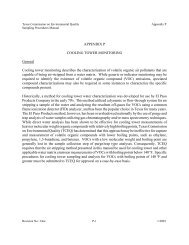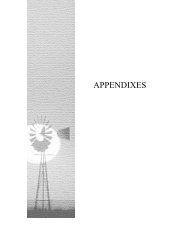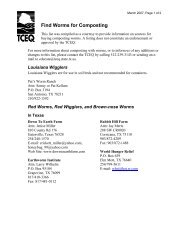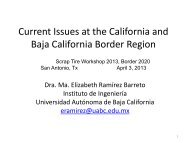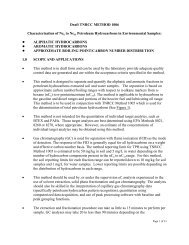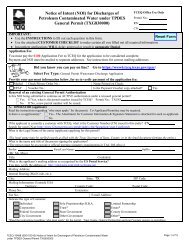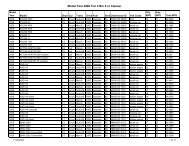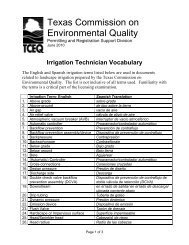vegetati<strong>on</strong> or small areas <str<strong>on</strong>g>of</str<strong>on</strong>g> woodland growing <strong>on</strong> north-facing slopes.There is some evidence that grassland <strong>on</strong>ce covered the lower slopes <str<strong>on</strong>g>of</str<strong>on</strong>g> the Guadalupe Mountains as wellas the higher elevati<strong>on</strong>s up to 7500 feet, and that desert shrubs invaded the area after it was overgrazed in thelate 19th century (Gehlbach 1979, Northingt<strong>on</strong> and Burgess 1979, Schmidley 2002). Today, yucca (Yucca spp.),sotol (Dasyliri<strong>on</strong> spp.), lechuguilla (Agave lechuguilla), ocotillo (Fouquieria splendens) and cacti (Opuntiaspp.) dominate rocky slopes below 5500 feet, but up to 6500 feet <strong>on</strong> exposed southern exposures and <strong>on</strong> thesteeper western escarpment. These shrub species are sometimes called succulent desert shrubs to distinguishthem from woody desert shrubs, such as creosotebush (Larrea tridentata) and tarbush (Flourensia cernua),typically found in the drier Chihuahuan Basins and Playas (24a) (Gehlbach 1979). Grasslands dominated bythreeawns (Aristida spp.), muhly (Muhlenbergia spp.), and gramas (Bouteloua spp.) persist near alluvial fansand <strong>on</strong> benches and gentle slopes with deeper soils (Northingt<strong>on</strong> and Burgess 1979).Several lizard species that are adapted to the exposed, sun-baked landscape <str<strong>on</strong>g>of</str<strong>on</strong>g> west <str<strong>on</strong>g>Texas</str<strong>on</strong>g> are indicative<str<strong>on</strong>g>of</str<strong>on</strong>g> the succulent desert shrubland: the round-tailed horned lizard (Phrynosoma modestum), the checkeredwhiptail (Cnemidophorus tesselatus), and the greater earless lizard (Cophosaurus texanus) (Gehlbach 1979).Other characteristic desert fauna are comm<strong>on</strong>, such as rattlesnake (Crotalusspp.), kangaroo rat (Dipodomys spp.), tarantula (Aph<strong>on</strong>opelma spp.),roadrunner (Geococcyx californianus), and, perhaps unexpectedly, muledeer (Odocoileus hemi<strong>on</strong>us), a large mammal that is also well-adaptedto desert life. In fact, in 1905 Vern<strong>on</strong> Bailey reported in his BiologicalSurvey <str<strong>on</strong>g>of</str<strong>on</strong>g> <str<strong>on</strong>g>Texas</str<strong>on</strong>g> that the mule deer was more numerous in the dry foothills<str<strong>on</strong>g>of</str<strong>on</strong>g> the western Guadalupe Mountains than it was in the wooded regi<strong>on</strong>s athigher elevati<strong>on</strong>s (Schmidley 2002). The mule deer can survive withoutwater for extended periods by getting moisture from the plants that it eats,such as the pulpy heart <str<strong>on</strong>g>of</str<strong>on</strong>g> the sotol plant. The heart <str<strong>on</strong>g>of</str<strong>on</strong>g> the sotol, or mescal,was also a staple in the diet <str<strong>on</strong>g>of</str<strong>on</strong>g> the Mescalero Apaches, who mastered theart <str<strong>on</strong>g>of</str<strong>on</strong>g> survival in the desert (Phelan 1976).The round-tailed horned lizard (Phrynosomamodestum) is a reptilian indicator <str<strong>on</strong>g>of</str<strong>on</strong>g> the succulentdesert shrubland in the Chihuahuan Desert.Photo: Erik Enders<strong>on</strong>, Tucs<strong>on</strong> Herpetological SocietyLevel IV Ecoregi<strong>on</strong>23a. Chihuahuan Desert SlopesArea (sq. mi.) 69Lower slopes <str<strong>on</strong>g>of</str<strong>on</strong>g> Guadalupe Mountains; very steep <strong>on</strong> west and south sides <str<strong>on</strong>g>of</str<strong>on</strong>g>Physiographyrange, more gradual <strong>on</strong> the east; cut by steep cany<strong>on</strong>s. Moderate gradient ephemeralstreams that carry water <strong>on</strong>ly after periodic storms.Elevati<strong>on</strong> /4500-6500 /Local Relief (feet)800-2000Pleistocene to Holocene clay loam colluvium and residuum mixed with limest<strong>on</strong>eSurficial Geology;and sandst<strong>on</strong>e fragments, gypsum deposits; Pleistocene to Holocene gravels andBedrock Geologysands in drainages.Permian limest<strong>on</strong>es, sandst<strong>on</strong>es, and clayst<strong>on</strong>es.Mollisols (Calciustolls), Aridisols (Haplocalcids, Petrocalcids), EntisolsSoil Order (Great Groups)(Torriorthents)Limest<strong>on</strong>e foothills, flat benches, and erosi<strong>on</strong>al slopes: Ector, Lozier, Rock outcrop.Comm<strong>on</strong> Soil SeriesAlluvial terraces and fans: Tencee, Tome.Soil Temperature /Thermic /Soil Moisture Regimes Ustic, AridicMean Annual Precipitati<strong>on</strong> (in.) 15-18Mean Annual Frost Free Days 180-210Mean Temperature (F) 29/52;(Jan. min/max; July min/max) 62/85On benches and slopes with deeper soil: grasses such as blue, black, and sideoatsgramas, purple threeawn, mourning lovegrass, curlyleaf muhly. On rocky slopes andVegetati<strong>on</strong>in disturbed grasslands: succulent desert shrubs such as sotol, lechuguilla, yucca,ocotillo, and cacti.Shrubland and grassland. Rangeland where not protected in Guadalupe MountainsLand Cover and Land UseNati<strong>on</strong>al Park.<str<strong>on</strong>g>Ecoregi<strong>on</strong>s</str<strong>on</strong>g> <str<strong>on</strong>g>of</str<strong>on</strong>g> <str<strong>on</strong>g>Texas</str<strong>on</strong>g> 5
Perennial streams are rare in the GuadalupeMountains <str<strong>on</strong>g>of</str<strong>on</strong>g> Ecoregi<strong>on</strong> 23; stream channelsgenerally carry water <strong>on</strong>ly after storm events.Sparse vegetati<strong>on</strong>, typical <str<strong>on</strong>g>of</str<strong>on</strong>g> the ChihuahuanDesert, grows <strong>on</strong> lower mountain slopes.Photo Phil Gavenda.23b M<strong>on</strong>tane WoodlandsThe M<strong>on</strong>tane Woodlands ecoregi<strong>on</strong> occurs above 5000 feet <strong>on</strong> the GuadalupeMountains <strong>on</strong> north slopes and in stream riparian z<strong>on</strong>es and above 6500 feet <strong>on</strong> southfacing slopes and <strong>on</strong> the steep western escarpment. This porti<strong>on</strong> <str<strong>on</strong>g>of</str<strong>on</strong>g> Ecoregi<strong>on</strong> 23b isat the southernmost tip <str<strong>on</strong>g>of</str<strong>on</strong>g> the Ariz<strong>on</strong>a/New Mexico Mountains (23), surrounded bydesert <strong>on</strong> three sides. Compared to other mountain ranges in Ecoregi<strong>on</strong> 23, the extent<str<strong>on</strong>g>of</str<strong>on</strong>g> piny<strong>on</strong>-juniper woodland, oak woodland, and c<strong>on</strong>iferous forest is much reduced(Johnst<strong>on</strong> 1979). The mapped polyg<strong>on</strong> for Ecoregi<strong>on</strong> 23b is generalized and does not c<strong>on</strong>vey the patchynature <str<strong>on</strong>g>of</str<strong>on</strong>g> the woodland cover. Densities <str<strong>on</strong>g>of</str<strong>on</strong>g> juniper (Juniperus spp.), piny<strong>on</strong> pine (Pinus edulis), and oak(Quercus spp.) vary according to aspect. At middle elevati<strong>on</strong>s, a chaparral community occurs beneath thetrees, composed <str<strong>on</strong>g>of</str<strong>on</strong>g> shrubs such as desert ceanothus (Ceanothus greggii), alderleaf mountain mahogany(Cercocarpus m<strong>on</strong>tanus), and catclaw mimosa (Mimosa aculeaticarpa). The top <str<strong>on</strong>g>of</str<strong>on</strong>g> the plateau is grassy andpark-like with scattered juniper, piny<strong>on</strong> pine, and oak. Douglas-fir (Pseudotsuga menziesii), southwesternwhite pine (Pinus strobiformis), and p<strong>on</strong>derosa pine (Pinus p<strong>on</strong>derosa) grow in limited areas at the highestelevati<strong>on</strong>s (above 7000 feet) where more moisture is available (Northingt<strong>on</strong> and Burgess 1979). These areas<str<strong>on</strong>g>of</str<strong>on</strong>g> high elevati<strong>on</strong> c<strong>on</strong>ifers form a distinct level IV ecoregi<strong>on</strong> elsewhere in the Ariz<strong>on</strong>a/New Mexico Mountains(23), but in the Guadalupe Mountains the c<strong>on</strong>iferous area is too small to map at the 1:250,000 scale.The east and west faces <str<strong>on</strong>g>of</str<strong>on</strong>g> the Guadalupe Mountains are cut by a series <str<strong>on</strong>g>of</str<strong>on</strong>g> cany<strong>on</strong>s. Surface water isscarce; infiltrating rainfall percolates through the limest<strong>on</strong>e, creating caverns throughout the range and a fewsprings that emerge from sandst<strong>on</strong>e layers at 6000 feet or below. In the cany<strong>on</strong>s, Chihuahuan desert shrubs andhigher elevati<strong>on</strong> c<strong>on</strong>ifers mix with deciduous riparian trees such as chinkapin oak (Quercus muehlenbergii),wavyleaf oak (Quercus pauciloba), and bigtooth maple (Acer grandidentatum). The cany<strong>on</strong>s support a highnumber <str<strong>on</strong>g>of</str<strong>on</strong>g> endemic plant species due in part to their isolati<strong>on</strong> as relics <str<strong>on</strong>g>of</str<strong>on</strong>g> a wetter climate; they also providevaluable habitat for s<strong>on</strong>gbirds that are characteristic <str<strong>on</strong>g>of</str<strong>on</strong>g> more northerly regi<strong>on</strong>s.McKittrick Creek Cany<strong>on</strong> is a center <str<strong>on</strong>g>of</str<strong>on</strong>g> biotic diversity and a focal point for visitors in Guadalupe MountainsNati<strong>on</strong>al Park. Several ice-age era woodland species are found here due to water and high, sheltering walls<str<strong>on</strong>g>of</str<strong>on</strong>g> the cany<strong>on</strong>. McKittrick Creek is c<strong>on</strong>sidered a perennial stream, although it <str<strong>on</strong>g>of</str<strong>on</strong>g>ten runs underground andends at the mouth <str<strong>on</strong>g>of</str<strong>on</strong>g> its cany<strong>on</strong>. Stream temperatures vary between 59°F near springs to 77°F in open shallowsecti<strong>on</strong>s. Two species <str<strong>on</strong>g>of</str<strong>on</strong>g> sunfish (Lepomis spp.) and rainbow trout (Salmo gairdneri), stocked in McKittrickCreek by previous landowners, are still present. The trout are able to survive and reproduce in the uppersecti<strong>on</strong>s <str<strong>on</strong>g>of</str<strong>on</strong>g> the creek at cooler spring sources (Lind 1979). Hanging terraces, or limest<strong>on</strong>e seeps, <strong>on</strong> the walls<str<strong>on</strong>g>of</str<strong>on</strong>g> McKittrick Cany<strong>on</strong>, support maidenhair fern (Adiantium capillus-veneris), sawgrass (Cladium mariscus),and the rare Chapline columbine (Aquilegia chrysantha var. chaplinei), mountain deathcamas (Zigadenuselegans), and mountain ninebark (Physocarpus m<strong>on</strong>ogynus) (Northingt<strong>on</strong> and Burgess 1979). The cany<strong>on</strong>ecosystems are vulnerable communities, even with Nati<strong>on</strong>al Park protecti<strong>on</strong>; they are vulnerable to flashflood and drought, browsing and trampling by elk and deer, and trampling by human visitors.Mule deer (Odocoileus hemi<strong>on</strong>us), black bear (Ursus americanus), mountain li<strong>on</strong> (Puma c<strong>on</strong>color), and6<str<strong>on</strong>g>Ecoregi<strong>on</strong>s</str<strong>on</strong>g> <str<strong>on</strong>g>of</str<strong>on</strong>g> <str<strong>on</strong>g>Texas</str<strong>on</strong>g>
- Page 1: Below is an Electronic Version <str
- Page 4 and 5: ECOREGIONS OF TEXAS</strong
- Page 6 and 7: TABLE OF CONTENTSABSTRACT..........
- Page 8 and 9: 2526272526272330293235332430323423
- Page 10 and 11: INTRODUCTIONSpatial frameworks are
- Page 12 and 13: Maps of environmen
- Page 16 and 17: the only chipmunk in Texas<
- Page 18 and 19: to the north. There is a high deman
- Page 20 and 21: taller, coarser tobosa grass (Pleur
- Page 22 and 23: the fractured rock. The Bof
- Page 24 and 25: hollows, moving upslope to create c
- Page 26 and 27: The headwater catfish (Ictalurus lu
- Page 28 and 29: streams. Two sand plains streams, C
- Page 30 and 31: Several caliche horizons (calcium c
- Page 32 and 33: winds (Spearing 199</strong
- Page 34 and 35: Geology is an important geographica
- Page 36 and 37: the villages of Pa
- Page 38 and 39: Area (sq. mi.) 5569PhysiographyFlat
- Page 40 and 41: Tableland topography of</st
- Page 42: y the Brazos and Colorado rivers ha
- Page 45 and 46: Level IV Ecoregion27i. Broken Red P
- Page 47 and 48: Post oaks (Quercus stellata) and bl
- Page 49 and 50: Level IV Ecoregion29c. Western Cros
- Page 51 and 52: than the limestone of</stro
- Page 53 and 54: underlying the sandstone. This has
- Page 55 and 56: Since settlement, many wildlife spe
- Page 57 and 58: (Pellaeae spp.), Nuttall’s stonec
- Page 59 and 60: Trinity-Edwards aquifer, discharges
- Page 61 and 62: Edwards Plateau to savanna-like con
- Page 63 and 64: species list, prefers fast moving w
- Page 65 and 66:
Level IV Ecoregion31a. Northern Nue
- Page 67 and 68:
31c Texas-Tamaulip
- Page 69 and 70:
31d Rio Grande Floodplain and Terra
- Page 71 and 72:
62shrink when dry and swell when we
- Page 73 and 74:
32b Southern Blackland PrairieThe S
- Page 75 and 76:
33 EAST CENTRAL TE
- Page 77 and 78:
and need some patchy distubances an
- Page 79 and 80:
33d Northern Prairie OutliersThe sm
- Page 81 and 82:
Level IV Ecoregion33e. Bastrop Lost
- Page 83 and 84:
34a Northern Humid Gulf Coastal Pra
- Page 85 and 86:
34b Southern Subhumid Gulf Coastal
- Page 87 and 88:
occasional discontinuous drainage r
- Page 89 and 90:
oundary was the ability to match th
- Page 91 and 92:
Level IV Ecoregion34f. Lower Rio Gr
- Page 93 and 94:
live oak trees (Quercus virginiana)
- Page 95 and 96:
Shoal grass (Halodule wrightii) mea
- Page 97 and 98:
Upland oak-pine forest in Ecoregion
- Page 99 and 100:
35c Pleistocene Fluvial TerracesThe
- Page 101 and 102:
35f FlatwoodsMostly flat to gently
- Page 103 and 104:
pasture, although some woodland sti
- Page 105 and 106:
invariant definition of</st
- Page 107 and 108:
how many stream sites/watersheds ar
- Page 109 and 110:
commonly believed. Typically, about
- Page 111 and 112:
CONCLUSIONS AND RECOMMENDATIONSThis
- Page 113 and 114:
104Ecoregions <str
- Page 115 and 116:
Biggs, B.J.F., M.J. Duncan, I.G. Jo
- Page 117 and 118:
Diggs, G.M., Jr., and P.C. Schulze.
- Page 119 and 120:
Graves, J. 2002. Texas</str
- Page 121 and 122:
Hunt, C.B. 1967. Physiography <stro
- Page 123 and 124:
Maxwell, T.C. 1979. Avifauna <stron
- Page 125 and 126:
Richmond, G.M., D.L. Weide, and D.W
- Page 127 and 128:
U.S. Department of
- Page 129 and 130:
Woods, A.J., J.M. Omernik, D.R. But
- Page 131 and 132:
Herbaceous Plants(Forbs, Grasses, a
- Page 133 and 134:
Hickory, BlackHickory, WaterHollyHu




